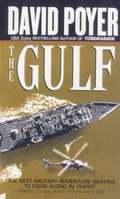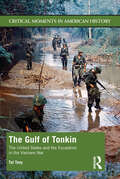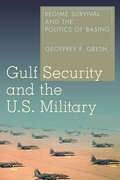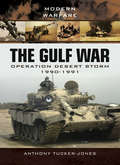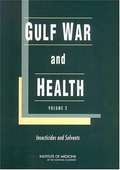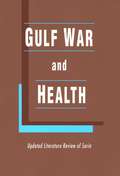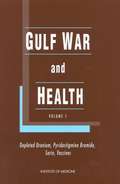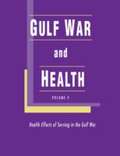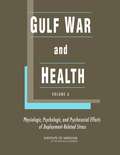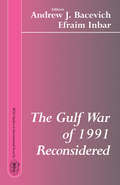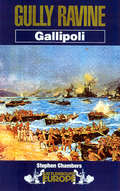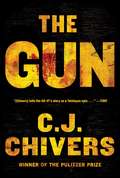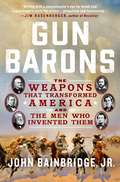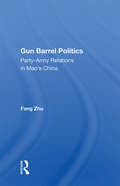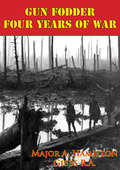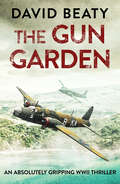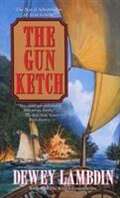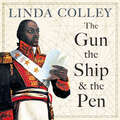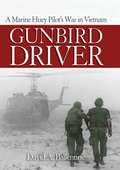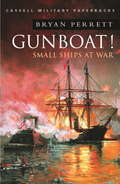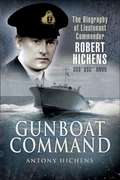- Table View
- List View
The Gulf (A Dan Lenson Novel #2)
by David PoyerAboard the guided-missile frigate U.S.S. Turner Van Zandt, Lieutenant-Commander Dan Lenson and his dedicated crew take on a daring assignment: escort a convoy of supertankers through the mine-filled Persian Gulf. For Lenson and his men, however, the danger is only just beginning. When a missile from a hit-and-run enemy sinks a U.S. destroyer, every ship and aircraft in the area goes on red alert. As all hands prepare for the inevitable showdown with a hostile Middle Eastern nation, Benjamin Shaker, the destroyer's hair-trigger captain, plots his own secret form of revenge. If he isn't stopped, it could mean disaster for the entire Gulf region-- and maybe the world!
The Gulf of Tonkin: The United States and the Escalation in the Vietnam War (Critical Moments in American History)
by Tal TovyThe Gulf of Tonkin: The United States and the Escalation in the Vietnam War analyzes the events that led to the escalation of the conflict in Vietnam and increased American involvement. On August 4, 1964, the captains of two American destroyers, the USS Maddox and the USS Turner Joy, reported that their ships were being attacked by North Vietnamese torpedo boats. This report came on top of a previous report by the captain of the USS Maddox, indicating that he had been attacked by torpedo boats two nights earlier. The text introduces readers to the historiography of these incidents and how the perception of the events changed over time. The attacks, which were collectively called the Gulf of Tonkin incident, are presented in the context not only of the Vietnam War but also of the Cold War and U.S. government powers, enabling students to understand the events’ full ramifications. Using essential primary documents, Tal Tovy provides an accessible introduction to a vital turning point in U.S. and international affairs. This book will be useful to all students of the Vietnam War, American military history, and foreign policy history.
Gulf Security and the U.S. Military: Regime Survival and the Politics of Basing
by Geoffrey F. GreshThe U. S. military maintains a significant presence across the Arabian Peninsula but it must now confront a new and emerging dynamic as most Gulf Cooperation Council countries have begun to diversify their political, economic, and security partnerships with countries other than the United States--with many turning to ascending powers such as China, Russia, and India. For Gulf Arab monarchies, the choice of security partner is made more complicated by increased domestic and regional instability stemming in part from Iraq, Syria, and a menacing Iran: factors that threaten to alter totally the Gulf's current security dynamic. Understanding the dynamics of base politicization in a Gulf host nation--or any other--is therefore vitally important for the U. S. today. Gulf National Security and the U. S. Military examines both Gulf Arab national security and U. S. military basing relations with Gulf Arab monarchy hosts from the Second World War to the present day. Three in-depth country cases--Saudi Arabia, Bahrain, and Oman--help explain the important questions posed by the author regarding when and why a host nation either terminated a U. S. military basing presence or granted U. S. military basing access. The analysis of the cases offers a fresh perspective on how the United States has adapted to sometimes rapidly shifting regional security dynamics and factors that influence a host nation's preference for eviction or renegotiation, based on its perception of internal versus external threats.
The Gulf War: Operation Desert Storm 1990–1991 (Modern Warfare)
by Anthony Tucker-JonesThis photographic history of Operation Desert Storm vividly captures the drama and humanity of each stage of the conflict. In the early 1990s, the American military led a coalition of United Nations forces to liberate Kuwait from Iraqi occupation. With more than 180 color photographs, The Gulf War provides a remarkable visual account of the conflict, documenting the vast array of military equipment deployed by both sides in the air, at sea and on land. Author and military expert Anthony Tucker-Jones, who was an analyst for British Defense Intelligence at the time of the conflict, describes the armed forces that were ranged against each other, including troops, armored vehicles, artillery pieces and aircraft. He also offers a concise overview of key events, including the preliminary air campaign, the elimination of the Iraqi navy, the coalition's ground offensive, tank battles, the liberation of Kuwait City, and more.
Gulf War and Health: Volume 2
by Committee on Gulf WarGulf War and Health, Volume 2, is the second in a series of congressionally-mandated studies by the Institute of Medicine that provides a comprehensive assessment of the available scientific literature on potential health effects of exposure to certain biological, chemical, and environmental agents associated with the Gulf War. In this second study, the committee evaluated the published, peer-reviewed literature on exposure to insecticides and solvents thought to have been present during the 1990-1991 war. Because little information exists on actual exposure levels - a critical factor when assessing health effects - the committee could not draw specific conclusions about the health problems of Gulf War veterans. However, the study found some evidence, although usually limited, to link specific long-term health outcomes with exposure to certain insecticides and solvents. The next phase of the series will examine the literature on potential health effects associated with exposure to selected environmental pollutants and particulates, such as oil-well fires and jet fuels.
Gulf War and Health: Updated Literature Review of Sarin
by Committee on Gulf WarThe Gulf War in 1990-1991 was considered a brief and successful military operation, with few injuries or deaths of US troops. The war began in August 1990, and the last US ground troops returned home by June 1991. Although most Gulf War veterans resumed their normal activities, many soon began reporting a variety of nonexplained health problems that they attributed to their participation in the Gulf War, including chronic fatigue, muscle and joint pain, loss of concentration, forgetfulness, headache, and rash. Because of concerns about the veterans' health problems, the Department of Veterans Affairs (VA) requested that the Institute of Medicine (IOM) review the scientific and medical literature on the long-term adverse health effects of agents to which the Gulf War veterans may have been exposed. This report is a broad overview of the toxicology of sarin and cyclosarin. It assesses the biologic plausibility with respect to the compounds in question and health effects.
Gulf War and Health
by Committee on Gulf War Health: Treatment for Chronic Multisymptom IllnessInfectious diseases have been a problem for military personnel throughout history. The consequences in previous conflicts have ranged from frequent illnesses disrupting daily activities and readiness to widespread deaths. Preventive measures, early diagnosis, and treatment greatly limit the exposures and acute illnesses of troops today in comparison with those in armies of the past, but infections and consequent acute illnesses still occur. Thousands of US veterans of the Persian Gulf War have reported an array of unexplained illnesses since the war ended in 1991. Many veterans have believed that the illnesses were associated with their military service in southwest Asia during the war. This volume of Gulf War and Health evaluates the scientific literature on chemical, biologic, and physical agents to which military personnel in the gulf were potentially exposed and possible long-term adverse health outcomes.
Gulf War and Health: Volume 1. Depleted Uranium, Sarin, Pyridostigmine Bromide, Vaccines
by Institute of MedicineMany combat troops who served in the Gulf War have suffered on-going health problems which may be linked to their wartime service. In response to the concerns of veterans and their families, the Department of Veterans Affairs contracted with the Institute of Medicine (IOM) to research possible connections between biological and chemical agents to which Gulf War veterans may have been exposed, and adverse health effects. This report presents findings from the first stage of the project, focusing on four agents: depleted uranium, pyridostigmine bromide, sarin, and vaccines. Reports on other agents will follow, in this long-term commitment to study all of the agents to which the veterans may have been exposed. Annotation c. Book News, Inc. , Portland, OR (booknews. com)
GULF WAR and HEALTH: HEALTH EFFECTS OF SERVING IN THE GULF WAR
by Institute of Medicine of the National AcademiesIn 1998, in response to the growing concerns that many returning Gulf War veterans began reporting numerous health problems that they believed to be associated with their service in the Persian Gulf, Congress passed two laws which directed the Secretary of Veterans Affairs to enter into a contract with the National Academy of Sciences. They were tasked to review and evaluate the scientific and medical literature regarding associations between illness and exposure to toxic agents, environmental or wartime hazards, and preventive medicines or vaccines associated with Gulf War service. In addition, the Institute of Medicine of the National Academy of Sciences provided conclusions to these studies that were considered when making decisions about compensation to veterans. Gulf War and Health Volume 4: Health Effects of Serving in the Gulf War summarizes in one place the current status of health effects in veterans deployed to the Persian Gulf irrespective of exposure information. This book reviews, evaluates, and summarizes both peer-reviewed scientific and medical literature addressing the health status of Gulf War veterans.
GULF WAR and HEALTH: VOLUME 6
by Institute of Medicine of the National AcademiesThe sixth in a series of congressionally mandated reports on Gulf War veterans' health, this volume evaluates the health effects associated with stress. Since the launch of Operation Desert Storm in 1991, there has been growing concern about the physical and psychological health of Gulf War and other veterans. In the late 1990s, Congress responded by asking the National Academy of Sciences (NAS) to review and evaluate the scientific and medical literature regarding associations between illness and exposure to toxic agents, environmental or wartime hazards, and preventive medicines or vaccines in members of the armed forces who were exposed to such agents. Deployment to a war zone has a profound impact on the lives of troops and on their family members. There are a plethora of stressors associated with deployment, including constant vigilance against unexpected attack, difficulty distinguishing enemy combatants from civilians, concerns about survival, caring for the badly injured, and witnessing the death of a person. Less traumatic but more pervasive stressors include anxiety about home life, such as loss of a job and income, impacts on relationships, and absence from family. The focus of this report, by the Institute of Medicine (IOM) Committee on Gulf War and Health: Physiologic, and Psychosocial Effects of Deployment-Related Stress, is the long-term effects of deployment-related stress. Gulf War and Health: Volume 6. Physiologic, and Psychosocial Effects of Development Related Stress evaluates the scientific literature regarding association between deployment-related stressors and health effects, and provides meaningful recommendations to remedy this problem.
Gulf War and Health: Update of Health Effects of Serving in the Gulf War, 2016
by National Academies of Sciences Engineering MedicineFor the United States, the 1991 Persian Gulf War was a brief and successful military operation with few injuries and deaths. However, soon after returning from duty, a large number of veterans began reporting health problems they believed were associated with their service in the Gulf. At the request of Congress, the Institute of Medicine (IOM) has been conducting an ongoing review of the evidence to determine veterans' long-term health problems and potential causes. The fourth volume in the series, released in 2006, summarizes the long-term health problems seen in Gulf War veterans. In 2010, the IOM released an update that focuses on existing health problems and identifies possible new ones, considering evidence collected since the initial summary. Gulf War and Health: Volume 10, the final volume of the series, is an update of the scientific and medical literature on the health effects associated with deployment to the Gulf War that were identified in Volumes 4 and 8. This report reviews and evaluates the associations between illness and exposure to toxic agents, environmental or wartime hazards, or preventive measures and vaccines associated with Gulf War service, and provides recommendations for future research efforts on Gulf War veterans.
Gulf War and Health: Volume 11: Generational Health Effects Of Serving In The Gulf War
by National Academies of Sciences Engineering MedicineFor the United States, the 1991 Persian Gulf War was a brief and successful military operation with few injuries and deaths. However, soon after returning from duty, a large number of veterans began reporting health problems they believed were associated with their service in the Gulf. At the request of Congress, the National Academies of Sciences, Engineering, and Medicine has been conducting an ongoing review of the evidence to determine veterans' long-term health problems and potential causes. Some of the health effects identified by past reports include post-traumatic stress disorders, other mental health disorders, Gulf War illness, respiratory effects, and self-reported sexual dysfunction. Veterans’ concerns regarding the impacts of deployment-related exposures on their health have grown to include potential adverse effects on the health of their children and grandchildren. These concerns now increasingly involve female veterans, as more women join the military and are deployed to war zones and areas that pose potential hazards. Gulf War and Health: Volume 11 evaluates the scientific and medical literature on reproductive and developmental effects and health outcomes associated with Gulf War and Post-9/11 exposures, and designates research areas requiring further scientific study on potential health effects in the descendants of veterans of any era.
The Gulf War of 1991 Reconsidered (Besa Studies In International Security)
by Andrew J. BacevichThe Gulf War of 1991 Reconsidered subjects one of the formative events of the post-Cold War era and a watershed in Middle Eastern international politics to a comprehensive reassessment. Condidering events from Arab, Israeli and American view points, the book examines the Gulf War's historical origins, conduct and legacy.
Gully Ravine: Gallipoli (Battleground Europe)
by Stephen ChambersThis book concentrates on Gully Ravine and its immediate area on the western side of the Helles battlefield. Here trench fighting raged throughout the campaign, culminating in the Battle of Gully Ravine between 28 June and 5 July 1915. This attack was a successful piece of planning and execution, enabling the British to capture five lines of Turkish trenches, seriously threatening the Turkish hold on the southern tip of the peninsula. After this attack the region fell into the deadlock of trench warfare, which brought its horrors as well as its monotony. This beautiful and picturesque area of Gallipoli is seldom visited, and its part in the campaign almost forgotten. The book is well researched and contains a high proportion of original photographs and maps, which have never been published before.
The Gun: The AK-47 and the Evolution of War
by C. J. ChiversAt a secret arms-design contest in Stalin's Soviet Union, army technicians submitted a stubby rifle with a curved magazine. Dubbed the AK-47, it was selected as the Eastern Bloc's standard arm. Scoffed at in the Pentagon as crude and unimpressive, it was in fact a breakthrough--a compact automatic that could be mastered by almost anyone, last decades in the field, and would rarely jam. Manufactured by tens of millions in planned economies, it became first an instrument of repression and then the most lethal weapon of the Cold War. Soon it was in the hands of terrorists.In a searing examination of modern conflict and official folly, C. J. Chivers mixes meticulous historical research, investigative reporting, and battlefield reportage to illuminate the origins of the world's most abundant firearm and the consequences of its spread. The result, a tour de force of history and storytelling, sweeps through the miniaturization and distribution of automatic firepower, and puts an iconic object in fuller context than ever before. The Gun dismantles myths as it moves from the naïve optimism of the Industrial Revolution through the treacherous milieu of the Soviet Union to the inside records of the Taliban. Chivers tells of the 19th-century inventor in Indianapolis who designs a Civil War killing machine, insisting that more-efficient slaughter will save lives. A German attaché who observes British machine guns killing Islamic warriors along the Nile advises his government to amass the weapons that would later flatten British ranks in World War I. In communist Hungary, a locksmith acquires an AK-47 to help wrest his country from the Kremlin's yoke, beginning a journey to the gallows. The Pentagon suppresses the results of firing tests on severed human heads that might have prevented faulty rifles from being rushed to G.I.s in Vietnam. In Africa, a millennial madman arms abducted children and turns them on their neighbors, setting his country ablaze. Neither pro-gun nor anti-gun, The Gun builds to a terrifying sequence, in which a young man who confronts a trio of assassins is shattered by 23 bullets at close range. The man survives to ask questions that Chivers examines with rigor and flair.Throughout, The Gun animates unforgettable characters--inventors, salesmen, heroes, megalomaniacs, racists, dictators, gunrunners, terrorists, child soldiers, government careerists, and fools. Drawing from years of research, interviews, and from declassified records revealed for the first time, he presents a richly human account of an evolution in the very experience of war.
Gun Barons: The Weapons That Transformed America and the Men Who Invented Them
by John Bainbridge Jr.John Bainbridge, Jr.'s Gun Barons is a narrative history of six charismatic and idiosyncratic men who changed the course of American history through the invention and refinement of repeating weapons.Love them or hate them, guns are woven deeply into the American soul. Names like Colt, Smith & Wesson, Winchester, and Remington are legendary. Yet few people are aware of the roles these men played at a crucial time in United States history, from westward expansion in the 1840s, through the Civil War, and into the dawn of the Gilded Age. Through personal drive and fueled by bloodshed, they helped propel the young country into the forefront of the world's industrial powers.Their creations helped save a nation divided, while planting seeds that would divide the country again a century later. Their inventions embodied an intoxicating thread of American individualism—part fiction, part reality—that remains the foundation of modern gun culture. They promoted guns not only for the soldier, but for the Everyman, and also made themselves wealthy beyond their most fevered dreams.Gun Barons captures how their bold inventiveness dwelled in the psyche of an entire people, not just in the minds of men who made firearm fortunes. Whether we revere these larger-than-life men or vilify them, they helped forge the American character.
Gun Barrel Politics: Party-army Relations In Mao's China
by Fang ZhuThis book tests the model of civil-military dualism to explain People's Liberation Army's (PLA) political engagement and its loyalty to the party in Maoist China. It explores how the party maintained its control— through penetration of the armed forces or non-intervention and civilian control.
Gun Fodder - Four Years Of War [Illustrated Edition]
by Major A. Hamilton Gibbs R.A.Includes the First World War Illustrations Pack - 73 battle plans and diagrams and 198 photosMemoirs of an officer, brother of the war correspondent, Philip Gibbs, who enlisted as a trooper in 9th Lancers, was commissioned into the Royal Artillery at the end of 1914, then served in Salonika and on the Western front.
The Gun Garden
by David BeatyA young Royal Air Force Pilot is sent on a dangerous mission in Malta in this WWII novel of love and war. Malta, 1942. As the Second World War rages, the strategically vital Mediterranean island of Malta is isolated, desperately short of supplies, and slowly being starved into surrender. Into this hopeless situation, the British send two Wellington aircraft equipped with secret long-range radar. Their role is to find enemy convoys proceeding at night from Italy to Africa, and to lead a tiny naval force through the darkness to their unsuspecting target. One is captained by a veteran R.A.F. pilot, the other is flown by Peter Forrester, a young and hastily trained kid is about to have his carefree spirit tested by the maelstrom of war. Thrown into this island of heroes, Peter also meets Miranda Black, daughter of a naval captain and a plotter in Barracca H.Q. Written by acclaimed author and R.A.F. veteran David Beaty, The Gun Garden is an authentic tale of gritty battle and young love.
The Gun Ketch: The Naval Adventures of Alan Lewrie (The Naval Adventures of Alan Lewrie #5)
by Dewey LambdinA fighter, rogue, and ladies man, Alan Lewrie has done the unthinkable and gotten himself hitched—to a woman and a ship! The woman is the lovely Caroline Chiswick. The ship is the gun ketch Alacrity, bound for the Bahamas and a bloody game of cat and mouse with the pirates who ply the lunatic winds there. But while war comes naturally to the young husband, politics doesn't. Sure that a powerful Bahamian merchant is behind a scourge of piracy, Lewrie runs afoul of the Royal Governor--who holds the most precious hostage of all.... From the windswept Carolinas to the exotic East Indies, Alan Lewrie fights and frolics with all the wild abandon of the high seas themselves. He's a true swashbuckling naval hero in the age of great sailing ships.
Gun Shy: The True Story of the Army Dog Scared of War
by Alison Stokes Angie McDonellVidar, the army search dog, has spent half his life sniffing out enemy weapons and bombs on the front line of the war in Afghanistan. His keen nose saved the lives of hundreds of soldiers, finding roadside bombs which could have killed British troops. But after two years of loyal service, Vidar became ‘Gun Shy’ – a term used to describe dogs who are frightened of loud noises. Whenever he heard bombs exploding or even the sound of helicopters flying above, he would curl up in the corner, shaking with fear.His army days were numbered… and his future looked uncertain. Until Angie, an army medic who befriended him during her tour of Afghanistan, made it her duty to give him a safe haven at her Welsh home.
The Gun, the Ship and the Pen: Warfare, Constitutions and the Making of the Modern World
by Linda Colley'If there were a Nobel Prize in History, Colley would be my nominee' Jill Lepore, New Yorker'One of the most exciting historians of her generation, but also one of the most interesting writers of non-fiction around' - William Dalrymple, Guardian'Colley takes you on intellectual journeys you wouldn't think to take on your own, and when you arrive you wonder that you never did it before' - David Aaronovitch, the Times'A global history of remarkable depth, imagination and insight' Tony Barber, Financial Times Summer BooksStarting not with the United States, but with the Corsican constitution of 1755, The Gun, the Ship, and the Pen moves through every continent, disrupting accepted narratives. Both monarchs and radicals play a role, from Catherine the Great of Russia, with her remarkable Nakaz, to Sierra Leone's James Africanus Horton, to Tunisia's Khayr-al-Din, a creator of the first modern Islamic constitution. Throughout, Colley demonstrates how constitutions evolved in tandem with warfare, and how they have functioned to advance empire as well as promote nations, and worked to exclude aswell as liberate.Whether reinterpreting Japan's momentous 1889 constitution, or exploring the significance of the first constitution to enfranchise all adult women on Pitcairn Island in the Pacific in 1838, this is one of the most original global histories in decades.
Gunbird Driver
by David A. BallentineGunbird Driver is a memoir of the Vietnam War as seen through the eyes of a young pilot flying an armed UH-1E's in Marine Observation Squadron 6. The book provides information about the missions, operations, and the living conditions at Ky Ha, and about the fellow Marines with whom he served. It also contains several chapters on shipboard operation from deployment aboard the USS Princeton. Parts of the book are deadly serious, even sad, as must be the case with any treatment of war; other parts are largely descriptive, and some circumstances and situations are even humorous. The time was 1966-67, relatively early in the war, the year before the Tet Offensive. The squadron's activities ranged widely in I Corps, the northern-most military subdivision of South Vietnam, the one assigned to the Marines. Although, the squadron and the air group to which it was attached (MAG -36) was assigned to the southern third of I Corps, it flew missions north along the DMZ, at Khe Sanh, west of Phu Bai and even into Laos, in addition to those in their local Tactical Area of Responsibility. Written to preserve a record of the impressions and experiences of one young 1st Lieutenant flying a Marine Huey in the war-torn skies of Vietnam, it is also reflective of all who crewed the UH-1E's - pilots, crew chiefs, and door gunners. It is a memoir that will resonate with all who crewed a "helo" in during the Vietnam war. No other book has been written on the Vietnam War from the perspective of a Marine Corps UH-1E pilot, flying armed escort missions for the Marines fighting the war on the ground.
Gunboat!: Small Ships At War (Sven Hassel War Classics)
by Bryan PerrettThis is naval action adventure with a difference - thirteen naval engagements in which gunboats won the day against every kind of enemy, large and smallBritain, like other colonial powers, established, controlled and accessed her empire from the seas. It was realised that the preservation of secure trading conditions required armed ships able to operate in shallow coastal and river waters. The gunboat was developed to meet this need: a small, shallow-draft, steam-powered screw or paddle driven vessel, sufficiently fast and manoeuvrable to take the enemy, whether on shore or afloat, by surprise.In this book Bryan Perrett recounts thirteen episodes of exciting gunboat action, ranging from the Burma war in 1824, through two world wars and on to the dramatic escape of the Amethyst down the Yangtze in 1949.
Gunboat Command: The Biography of Lieutenant Commander Robert Hichens DSO* DSC** RNVR
by Antony HichensThis biography draws heavily on the personal diaries of the subject, Robert Hichens (or Hitch as he was universally known).After a brief description of his early life, time at Oxford, his motor racing achievements (including trophies at Le Mans in his Aston Martin) and RN training, the book focuses on his exceptional wartime experiences. Hitch was the most highly decorated RNVR officer of the war with two DSOs, three DSCs and three Mentions in Despatches. He was recommended for a posthumous VC. We read of his early days in vulnerable minesweepers and the Dunkirk Dynamo operation, (his first DSC).In late 1940 he joined Coastal Forces serving in the very fast MGBs, soon earning his own command and shortly after command of his Flotilla. He was the first to capture an E-Boat. His successful leadership led to many more successes and his reputation as a fearless and dynamic leader remains a legend today.The book contains detailed and graphic accounts of running battles against the more heavily armed E-boats. Tragically he was killed in action in April 1943, having refused promotion and a job ashore.
